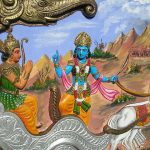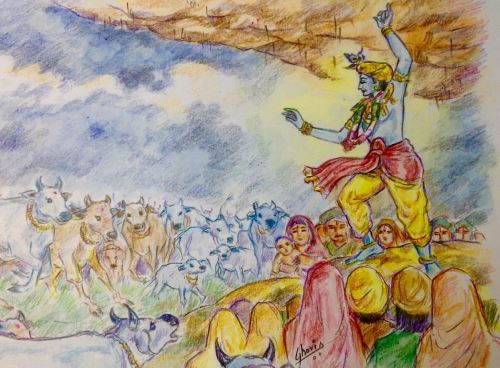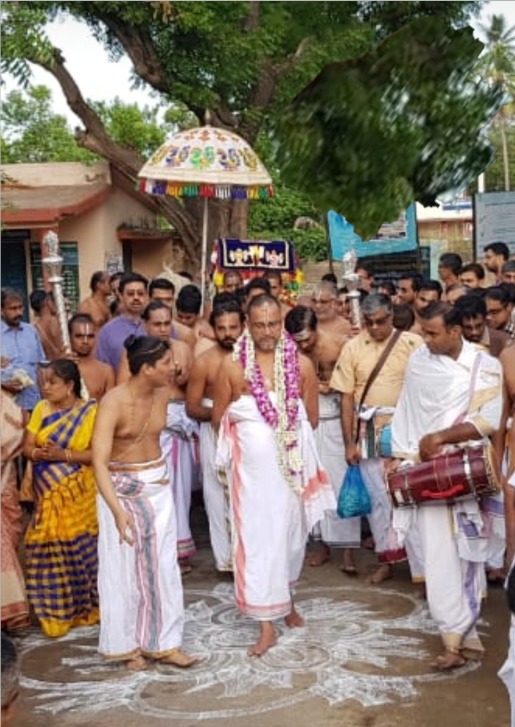A person comes to Satsang somehow because of some punya (merits). There he even gets the association of a Mahan. He even develops an incomprehensible attraction towards the saint. He listens to the nectarine devotional discourses showered by him; he also sees him living the experience of bhakti continuously with such immense love and enjoyment.
At that time he feels, “Will I also not get such bhakti as this? Isn’t the purpose of life itself Krishna bhakti? I want to do bhakti like that, but the vasanas carried through millions of births rise up as wretched thoughts. The body too sometimes does not cooperate. I set out for the Utsavam, but illness comes and becomes an obstacle to divine experience. Inborn qualities such desire, anger, etc. are waiting, ready to spoil bhakti. But making us feel that even all this is ok, above all of this there is the ego of “I” and “mine” that rises up now and then, that are huge hurdles!”
While he was struggling, not knowing what to do, he went to the discourse of the Mahan, who was his Guru. Like always, on that day also, the questions in his mind were answered in the discourse itself.
The Sadguru said:
“Bhagavan Sri Krishna says in Bhagavad Gita’s bhakti yoga, ‘The one who, continuously, without taking up any other sadhana, without any other thought, does prema bhakti, he is the greatest among those who have united with the Truth’.
“I understand what you are thinking. You may worry, ‘When we have not yet attained maturity in bhakti yoga, a lot of obstacles come up. What can we do?’ For this also, Bhagavan says ‘abhyasa yogena’, i.e. until complete bhakti is attained, one should continue to do bhakti through proper, persistent, sincere effort and through prayer to Krishna for developing bhakti. Then, in the course of time, Krishna makes the ambiance conducive for bhakti. And with His grace, bhakti will then be attained.
In the 11th Canto, 28th chapter of Srimad Bhagavatam, as His final upadesa to Uddhava, Krishna speaks in detail about what we have to do to progress in the spiritual path, while in a state when we have not yet reached the goal of bhakti yoga and jnana yoga.
Sri Krishna says that we have to look at our body as a banana leaf. Until we eat, we have to maintain the leaf carefully, without tearing it, by keeping it clean and without folds. But after eating, we can throw it away without any worry, isn’t it? The use of the leaf itself is only until we eat on it. Similarly, we have to take care of our body until we attain Bhagavan, until jnana rises in us. If hindrances such as illnesses and diseases come even before bhakti and jnana are attained, then Krishna clearly tells Uddhava that we have to take steps to mitigate the problems.
Among all paths, our Bhagavata Dharma shows a practical approach. If, on the pretext of doing bhakti, we do not take care of the body, how can we progress in the path? So Bhagavan says that we have to take care of the body carefully, as much as is needed for sadhana. The body’s excess heat and cold have to be set right using Chandra Surya yoga. With practices such as pranayama, yogasana, we have to fix illnesses related to vaatam (imbalance of air in the body). With penance (vrathas and fasting), we have to reduce our sins; with mantras we have to neutralize harmful planetary effects; with medicine, we have to weed out ailments such as poisonous tumors.
Bhakti sadhana should be performed using this body only, right? See how clearly Bhagavan Himself says that we have to take care of the body. Saying that ‘I am doing bhakti’, if we spoil our health or move around in dirty clothes, that is not spiritual progress.
It is not enough if we only take care of the body for spiritual progress. Should we not also bring our mind under control? For that too, our Krishna beautifully shows the way. Doing dhyana of Krishna whenever possible; listening to the stories from Bhagavatam and of the Lord; doing Nama sankirtanam – through these we have to destroy the mind’s enemies such as desire, anger, etc.
Finally how to clean filth such as the ego, I-ness, mine-ness, and pride?
Krishna says beautifully, ‘These have to be slowly removed through sincere service to a Sadguru who is a Yogeeswara.’ With this, He completes His upadesa.
Yes, the main purpose of Guru kainkaryam is to completely root out our ego only!
In this, we have to observe one thing. For those who are treading the path of Bhagavata Dharma and bhakti, without giving any yoga sadhana or jnana sadhana to control the mind, Krishna instead shows the great path of Krishna shravana-kirtana-smarana-dhyana and Guru kainkaryam!”
When that devotee heard this, he was extremely happy. He prostrated mentally again and again to his Guru, who has beautifully shown and inspired us in this path of Bhagavata dharma that fits with our lifestyle, and began to walk majestically with more enthusiasm in this kingly path, in his journey of bhakti.
by M.K. Ramanujam, Chennai, India
Originally published in Tamil, in MadhuraMurali monthly magazine, January 2018 issue.






